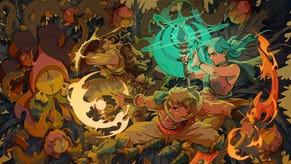Shadow Gambit: The Cursed Crew review - old-school stealth gets a rip-roaring pirate upgrade
Alone in the darrrrghk.
Let us speak of the bong; if death is inevitable in Shadow Gambit, then so too is the tremulous peal of the Red Marley's phantom bell. With the press of a button, it chimes across the ethereal plane, solidifying a moment into a memory, and with another button, the past becomes present as the memory is restored: in an instance, lessons are learned, mistakes are undone, the slate is wiped clean to try, try again.
It's a temporal dance that'll be immediately familiar to those who've played developer Mimimi's previous games. With the likes of Shadow Tactics and Desperados 3, the studio has carved a wonderfully specific niche for itself over the years, creating top-down squad-based stealth-tactics games very much inspired by genre classics like Commandos and Desperados - where margin for error is minimal and save scumming is elevated to high art. That one-two of quick-save and quick-load - here represented by the Red Marley's thunderous bong - might be familiar, but in Shadow Gambit it also feels different somehow. Its bong is so profoundly, theatrically woven into the fabric of its story, so brazenly part of its identity - crashing in amid swirling green mists at one end, smashing violently out of shattering glass at the other - it becomes a mechanic proudly, confidently made motif, and goodness, is Shadow Gambit assured.
That starts with the setting; while Mimimi’s earlier games played it relatively straight in terms of historical realism, Shadow Gambit presents a wonderfully realised alternative vision of the golden age of piracy, where cursed undead crews roam the seas battling an order of religious fanatics known as the Inquisition. At the centre of it all is Afia Manicat, an ambitious undead pirate with a plan in her head, a conveniently accessible cutlass through her heart, and, after a confidently swashbuckling opening, an invitation to join the crew of the Red Marley, a sentient ship currently on the hunt for its former captain’s legendary treasure.
It's gloriously characterful stuff, a full-blooded high seas adventure full of magic, camaraderie, and danger. Grog is glugged, buckles are swashed, and timbers are shivered, but Mimimi infuses proceedings with its own darkly fantastical vision. This is a world of sentient jungles, islands perpetually frozen at the point of destruction, ethereal dimensions of shattered memories and, during character-specific interludes that play out between missions on the Red Marley, murder plots, and even fish looking to be tutored in the ways of the shinobi.
But for all its pirate trimmings, Shadow Gambit remains steadfastly in the tradition of Mimimi's earlier titles, thrusting players deep into enemy-infested territory for a ceaseless game of dodge the sight cone. You've got a starting point, an end point, and a billion enemies in-between. The what, then, is easy - slip quietly from one to the other without raising the alarm - but the how is another matter entirely, and the tactical heart of the game.

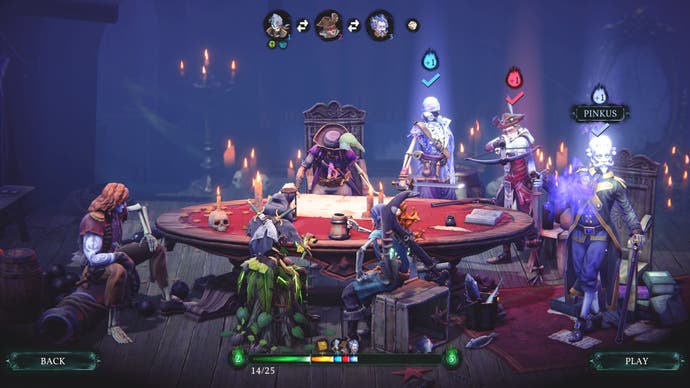
Yes, you'll spend an awful lot of time patiently crouching in bushes as you scour your surroundings, searching out pathways and potential openings, memorising patrols, but then comes the really fun bit: the thrill of freewheeling experimentation as you rapidly cobble together a plan, manoeuvre your squad mates into a position and (all being well) unleash your full tactical might, clearing the route forward in a silent dance of synchronous destruction. It's a game, like its predecessors, built around constant repetitions of escalating tension and climactic release, but here it's brought to life with irresistible piratical swagger. Aesthetically, it's a hoot - beautifully presented, wonderfully voiced, sharply written - but more than that, Shadow Gambit's world unshackling itself from reality gives Mimimi licence to take its familiar stealth-tactics formula into uncharted realms, and it embraces that fantastical potential at every turn.
That manifests most acutely in Shadow Gambit's supernaturally imbued crew. Each of its eight playable characters might be constructed from a relatively slender set of mechanical archetypes - position changers, body hiders, infiltrators, and so on - but the imaginative ways Mimimi plays within those fixed boundaries to build out a distinctive set of signature skills is never less than thrilling. Afia can maim-dash from extended distances or freeze enemies in time; eyeless Spanish sniper Teresa la Ciega can temporarily blind or murder from afar, using a bullet fashioned from her very soul. There's Toya of Iga, a skeletal shinobi cook whose paper teleportation charms and whistle create a fascinatingly intricate combination of dovetailing abilities, enabling players to lure enemies to a specific spot then teleport into a now-vacated space or on top of them for a quick kill. There's Pinkus, a stuffy baron who can possess enemies and walk around encampments undisturbed; John, a sodden shipwright with a friendly undead fish chum, can move around beneath the ground, dragging unsuspecting enemies to their doom - and on it goes.

It all adds up to a diverse tactical toolkit that remains a joy to use throughout, with ample room for ad hoc synergies, flashes of sudden inspiration, and moments of 'OH BUT WHAT IF…' As Toya frequently says, "Our options for variety are endless". But while these abilities are often thrilling - a supernatural skillset that provides the perfect flashy counterpoint to those inevitable moments of quietly strategic contemplation - just as exciting are the carefully considered limitations each unit must operate within. Teresa la Ciega's single bullet must always be retrieved before it can be used again; Pinkus' possession ability only works within a fixed radius from the point of entry; Toya's whistle lure has a perilously large area of effect meaning reckless use is unwise. There are even restrictions on who can swim and climb vines, creating often unpredictable environmental roadblocks that demand creative strategic rethinks on the fly.
Shadow Gambit is a game that knows how to make choices interesting and, duly, one that never fails to give you interesting choices to make. Even before missions, there are questions to be answered, starting with: Where do you want to go? Often, you've several possible islands to visit, each with multiple objectives set across different locations and varying times of day. Then you're asked, which three crew mates will you take into a mission? That's a lot of potential synergies to consider before you even reach your destination, and when you do, there's another choice: where on the island do you land? Do you plot a course through the quickest route to your objective, or the safest? And stages, too, are often vast, intricate things to parse and process, looping up cliffs, down into valleys, criss-crossing back and forth over bridges, into alleyways - each diverging path another tactical option available to you.
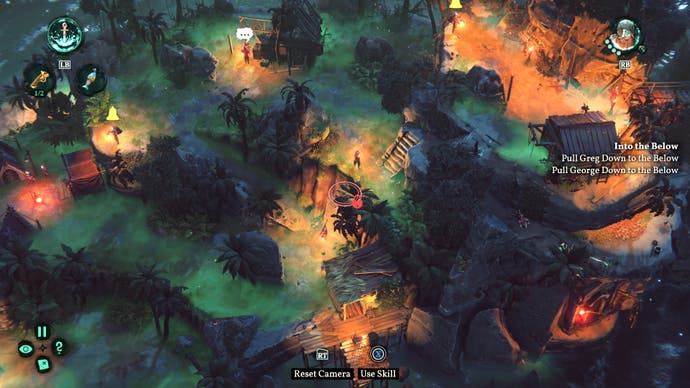
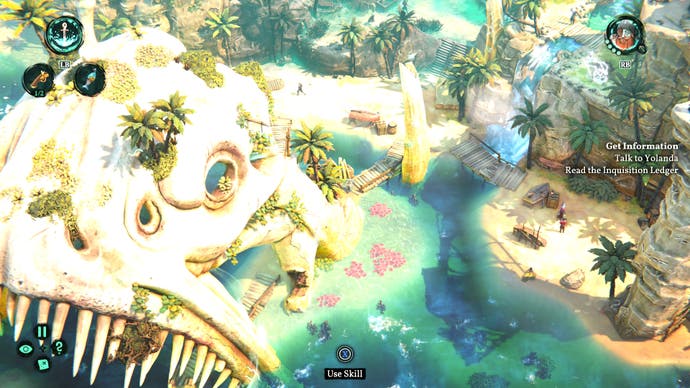
There's a lot to consider, then, but crucially Mimimi also knows when to rein those choices in. For all its flashy action pizazz, Shadow Gambit remains a slow-paced, sometimes intensely cerebral game, but it's also one that's patient and welcoming to a fault, eager to ease entry so everyone can join in the fun. There’s the foregrounding of that bong, for instance, a persistent reminder that failure isn't a punishment but a fresh opportunity to try something new. Then there's the unexpectedly slow drip-feed of new crewmates throughout the story campaign; you can choose who to resurrect along the way, but you won't gain access to the full roster until late on, just before the post-game, meaning you've little choice but to embrace the nuances of each, ultimately encouraging a much richer, better informed style of play.
It's just one of several tricks Mimimi uses to nudge players away from bad habits and self-limiting behaviours; impenetrable clusters of enemies encourage players over-reliant on particular crew members to think in terms of unified assaults, while other enemies, magically connected across long distances so that they must be felled in unison, often require team mates to take significantly diverging paths, forcing their individual strengths to the fore. There's even an upgrade system foundationally built around unused characters; each time a crew mate sits out a mission, they'll provide a massive XP boost next time around, strongly incentivising those characters to be brought into play. It's clever stuff, subtly, elegantly making a sometimes impenetrable genre eminently more approachable.
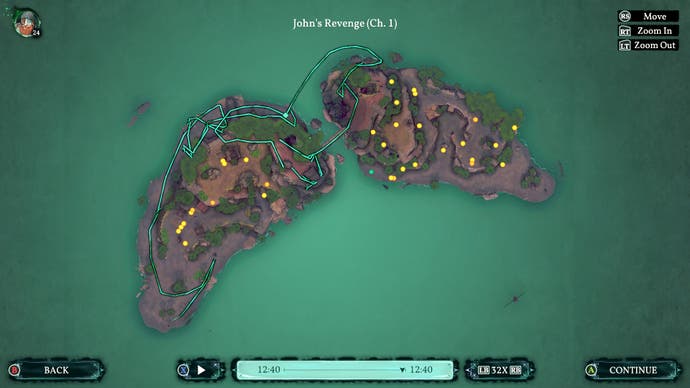
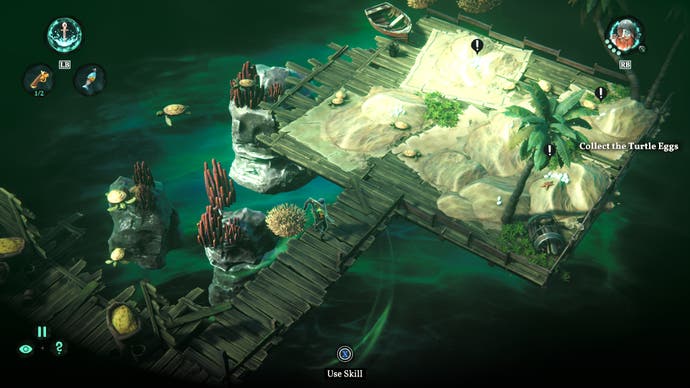
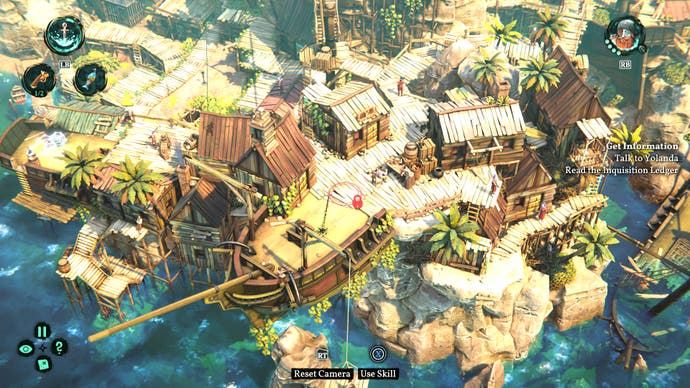
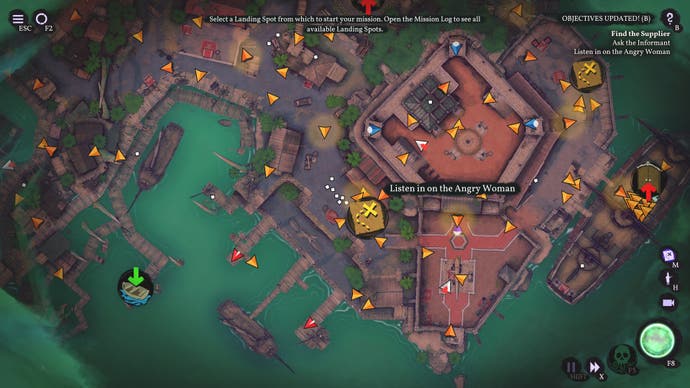
There's so much confident refinement here that it's perhaps a little surprising to see Shadow Gambit's occasional failure to grapple with some of the more fundamental failings of its staunchly old-school genre core. Objectives, for instance, remain curiously, unwaveringly unambitious, which, for all the richness of its wonderful toolkit, can make the inherent micro-loops of its slow-paced stealth wearying at times. It's hard, too, to fully embrace its lingering attachment to the archaic abstraction of swaying sight cones. When you can stand an inch to the side of an enemy without being seen, or take a single step back to become functionally invisible, the tactical illusion collapses and Shadow Gambit gets perilously, unsatisfactorily close to becoming a game of mechanical exploitation.
These are rare moments, though, and, for the bulk of its lengthy run-time - expanded through post-game objectives designed to encourage further experimentation - Shadow Gambit is a treat; a thrilling, supremely confident, and most of all thoughtful refinement of a formula that only occasionally lets its decades-old roots peek through. Raucous, high seas adventure and cerebral, slow-paced stealth mightn't seem like the most natural of bedfellows, but here, Mimimi's joyous mastery of a very particular form somehow makes the combination sing.




